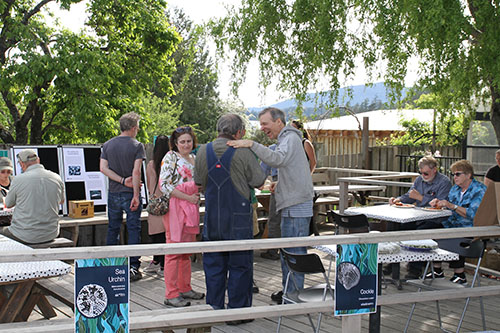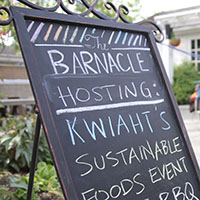— by Ayn Gailey —
 Because we live on an island we should be just as serious about sustainable seafood as sustainable farming. This was one of the key takeaways from Kwiáht’s free Sustainable Seafood Barbecue event hosted by The Barnacle last week. According to Kwiáht organizers Russel Barsh and Madrona Murphy, the concept of seafood sustainability includes making marine resources available for consumption as important a priority as protecting shorelines and endangered salmon and other marine species.
Because we live on an island we should be just as serious about sustainable seafood as sustainable farming. This was one of the key takeaways from Kwiáht’s free Sustainable Seafood Barbecue event hosted by The Barnacle last week. According to Kwiáht organizers Russel Barsh and Madrona Murphy, the concept of seafood sustainability includes making marine resources available for consumption as important a priority as protecting shorelines and endangered salmon and other marine species.
“We don’t produce enough food on Orcas to last us even a few days,” says Barsh. “We are critically dependent on imported food and that should not be the case.” We do have an abundance of seafood in our very own waters, but just as the majority of our farmed fare is sold off island, so, too is our seafood. Complicating matters are state restrictions limiting when island residents can crab and fish. According to Barsh, “currently, seventeen Indian tribes with treaty rights to fish and commercial fisherman fish our waters year-round with most of their bounty being sold in Seattle,” ironically leaving Orcas residents with little of our own seafood supply chain for consumption for much of the year.
 Smelt, salmon, and coon stripe shrimp, all available in our waters, were served at the well-attended event at The Barnacle. The smelt was served in part to educate Orcas Islanders on the concept of eating lower on the food chain. Why should one eat lower on the food chain? According to Murphy, one reason is because you’ll consume less toxins. “The higher up you go in the food chain, the bigger accumulation of toxins,” she explains. Smelt—not bottom feeders as many believe—are consumed by salmon, which, are in turn, consumed by Orcas.
Smelt, salmon, and coon stripe shrimp, all available in our waters, were served at the well-attended event at The Barnacle. The smelt was served in part to educate Orcas Islanders on the concept of eating lower on the food chain. Why should one eat lower on the food chain? According to Murphy, one reason is because you’ll consume less toxins. “The higher up you go in the food chain, the bigger accumulation of toxins,” she explains. Smelt—not bottom feeders as many believe—are consumed by salmon, which, are in turn, consumed by Orcas.
However, in another complicated twist preventing islanders from consuming their own seafood, “Smelt has been protected by the state because state studies show that higher levels of smelt aid in salmon recovery,” explained Barsh. However, he also shared that more localized research proves that when endangered Chinook salmon approach our island waters, they switch to a fish diet that does not include smelt.
The more one listens to Barsh, the more one realizes that his suggestion that islanders should be eating more seafood, is a simple idea that goes beyond health and a sustainable eco-system. On an island where many residents cannot afford to buy meat from our very own farms, nor afford fish or crab—the few months it is actually available—from our very own markets, empowering residents with the ability to fish and crab year-round to feed our island population seems like a natural right we should own. On the commercial side, Barsh and The Barnacle owners imagine food-serving establishments like The Barnacle, restaurants, and our local seafood farms having the ability to fish year-round, creating a food mecca of menu items they can’t get elsewhere, harvested from our own shorelines. This feeds locals, not just tourists—especially ones not likely to fish themselves—and allows our food supply to bring dollars back into our county instead of King County.
So, what can we do? “One idea being discussed,” according to Barsh, “is incorporating Alaska’s generous system of subsistence fishing.” Simply put, subsistence fishing in Alaska means it’s the right of rural Alaskans to fish all year around to feed themselves. It’s great to share the seafood others reap from our shorelines but, if one can learn anything from the research of Kwiáht, perhaps it is that we should think about ensuring that we can support ourselves before we share with others.”
Kwiáht is a nonprofit conservation biology laboratory in and for the San Juan Islands of Washington State. To learn more visit www.Kwiaht.org/.
**If you are reading theOrcasonian for free, thank your fellow islanders. If you would like to support theOrcasonian CLICK HERE to set your modestly-priced, voluntary subscription. Otherwise, no worries; we’re happy to share with you.**









This raises a critical issue dealt with by Elinor Ostrom (not an economist) who won the 2009 Nobel Prize in Economics) for her book “Governing the Commons.” It’s available in paperback and is easily readable. It involves local control (agreed availability, agreed restraint) over local assets, recognizing that the locals themselves can easily overuse the common resource.
In supporting ourselves before sharing with others…..where does that leave the Orcas?
I would Love some shrimpbut can do without salmon…i hear our pods do not have enough but costco features huge displays, wedding parties feature salmon, restaurants have salmon all year long. Since our population is closest to the Orcas should not we take responsibility in seeing to restrictions of how much is taken and when?